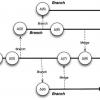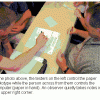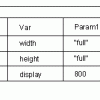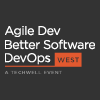|
|
Four Techniques to Wrap Your Head Around Complicated Code Software people love challenges and want to exercise their brains by tackling difficult problems. Our nature is to understand complicated problems, become familiar with various business domains, and generate a solution that helps the world become a better place. Nirav Assar explains four techniques to wrap your head around complicated code.
|
|
 |
End-of-Release Branching Strategies This two-part article explores branching strategies—development tactics that allow teams to work concurrently on different features and maintain the relationship between them. In part one, Steve Berczuk explains what branches are, common types of them, and the tradeoffs between branching styles.
|
|
 |
Test Software before You Code Testing doesn't have to begin after the code has been written. In this column, Jeff Patton resurrects the oldest and most overlooked development technique, which can be used to test a product before any piece of it materializes.
|
|
 |
How to Merge XML Data with a Database In his article "Data Crunching Tips and Techniques," Greg Wilson taught us how to translate legacy data into XML. In the second half, he explains how to merge new data into an existing database. Developers will always face these types of data crunching problems, and knowing the standard data crunching tools can save you a lot of time. Greg also shares the basic knowledge about relational databases that every developer should possess.
|
|
 |
What if Someone Steals Your Code? Bob Zeidman, an expert in software forensics, provides a great overview of how to protect your software from predators. You'll learn the difference between copyrights, trade secrets, and patents.
|
|
 |
The Rules for Writing Maintainable Code We've all been burned working with software code that, if not designed for long-term maintainability, results in expensive support over a product's lifetime. Kaushal explores three approaches that provide guidelines to ensure that software is designed with maintainability in mind. If you're a software developer, read this!
|
|
|
|
Alternative JVM Languages For Java Projects Java Virtual Machine has become a successful platform for applications written in many languages, not just Java. Alternatives like JRuby, Scala, Clojure, and Groovy can be more concise and offer new ways to approach problems.
|
|
|
|
An Introduction to Scala Scala is a programming language that blends functional and object-oriented language features. Scala programs run on the Java Virtual Machine and can easily interact with Java code. Learn how Scala can yield concise, safe, and compatible code and how you can start learning Scala on your own.
|
|
 |
Making Testers Miserable: An Interview with Andrew Wulf Andrew Wulf runs TheCodist blog, is the lead iOS programmer for Travelocity, and owns Idle Diversions—an iOS game company. In this interview with Noel Wurst, Wulf discusses his role as a coder to "make testers miserable," the need for clean code, and practicing agile before it was a term.
|
|
 |
Worse Is Better Revisited: An Interview with Kevlin Henney Kevlin Henney believes that it's time to revisit the thinking behind "Worse is Better," which he does in this interview with Noel Wurst. Kevlin explains that by getting past the catchiness of the phrase, and really digging deep into its real meaning, there's a real sense of agile underneath.
|
|
 |
How to Hear Your Unhappy Code: An Interview with Cory Foy Cory Foy uses more than a decade of experience with agile and lean development to help developers create cleaner code, and also be able to know—or "hear"—when their code is unhappy. In this interview, Cory shows why constantly learning and evolving your language skills is so important.
|
|
 |
What's That Smell? Tidying Up Our Test Code
Slideshow
We are often reminded by those experienced in writing test automation that code is code. The sentiment being conveyed is that test code should be written with the same care and rigor that production code is written with. However, many people who write test code may not have experience writing production code, so it’s not exactly clear what is meant. And even those who write production code find that there are unique design patterns and code smells that are specific to test code. Join Angie Jones as she presents a smelly test automation code base littered with several bad coding practices and walks through every one of the smells. She'll discuss why each is considered a violation and via live coding, she will demonstrate a cleaner approach. While all coding examples will be done in Java, the principles are relevant for all test automation frameworks.
|
Angie Jones
|
 |
Connected Devices, Connected Code, and Connected Teams: The Challenges of IoT Software Delivery
Slideshow
Developing software for the Internet of Things (IoT) comes with its own set of challenges and issues, including security, privacy, and unified standards. Each IoT product is comprised of (at least) three separate application components: the software embedded in the device, the backend...
|
Anders Wallgren
|
 |
IoT—Let’s Code Like It’s 1999!
Slideshow
Everyone is drawn to the cool new ways to connect devices to the Internet and make life easier—and a little more futuristic. But, do you know that IoT has been around since the past century? Theresa Lanowitz is one of the early advocates of what is now IoT and is thrilled that the pace of...
|
Theresa Lanowitz
|
 |
The Soft Skills of Great Software Developers
Slideshow
Are you creating clean, high performing code? Are you following the right development practices, but still don’t feel you are getting the recognition or success you deserve? The truth is that working harder and improving your programming skills are not enough. Great developers must...
|
Raul Suarez
|
Visit Our Other Communities
AgileConnection is a TechWell community.
Through conferences, training, consulting, and online resources, TechWell helps you develop and deliver great software every day.

